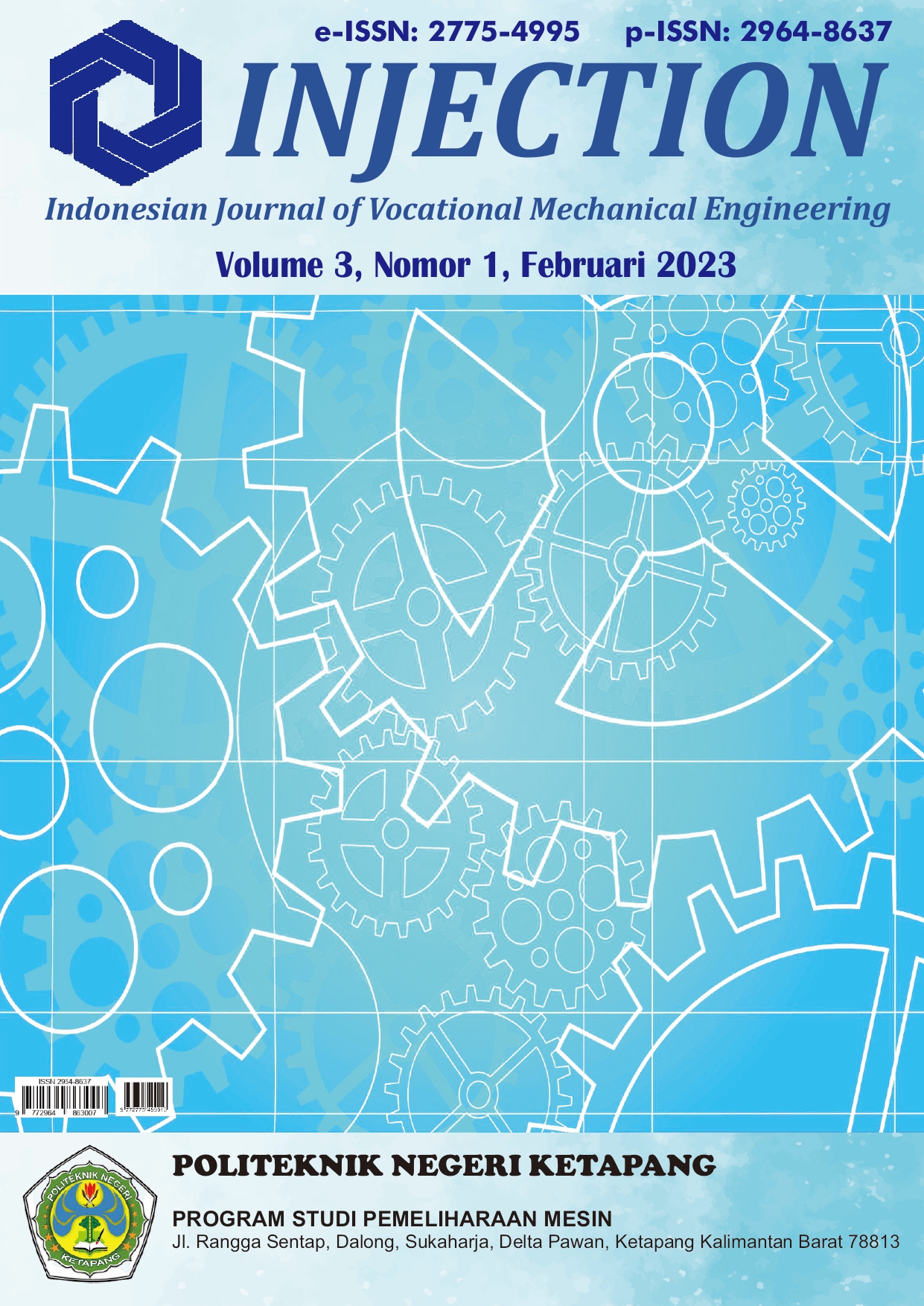PERANCANGAN SISTEM PENEMBAKAN MENGGUNAKAN MOTOR SERVO MG996R UNTUK AUTONOMOUS ROBOT GUN (ARO-GUN)
DOI:
https://doi.org/10.58466/injection.v3i1.1492Kata Kunci:
Akurasi, Kontrol, PenembakanAbstrak
Teknologi persenjataan yang terus berkembang dan semakin canggih menjadikan negara-negara terus mengembangkan senjata otomatis. Pengendalian pergerakan dan posisi senjata yang dilakukan secara manual sangat sulit mendapatkan tingkat akurasi yang tinggi, sehingga ketidakakuratan dalam penembakan dapat menimbulkan korban jiwa. Untuk meminimalisir hal tersebut maka dibutuhkan penggerak senjata secara otomatis. Pada penilitian ini dikembangkan sebuah produk bernama ARO-GUN yang dapat melakukan penguncian dan penembakan target dengan menggunakan motor DC jenis servo MG996R. Produk ARO-GUN ini berdasarkan pengujian memiliki ti ngkat akurasi dalam melakukan penguncian dan penembakan pada sumbu X rata-rata sebesar 98,51% dan rata-rata error sebesar 1,50% sedangkan pada sumbu Y memiliki tingkat akurasi rata-rata sebesar 97,97% dan rata-rata error sebesar 1,94%.Berdasarkan penilitian dan pengujian yang telah dilakukan dapat di simpulkan jika sistem penembakan pada produk ARO-GUN ini dapat mempermudah kinerja militer dalam penggunaan senjata serta dapat meminimalisir adanya korban jiwa akibat kesalahan dan ketidakakuratan dalam melakukan penembakan.
Referensi
S. Syarief and F. A. Rismawa, “Autonomous Target Tracking,” J. Poli-Teknologi, vol. 17, no. 2, pp. 121–128, 2018, doi: 10.32722/pt.v17i2.1232.
I. A. Laksmita, “Dampak Perang Dunia II,” Diglosia J. Kaji. Bhs., vol. 4, no. 2, pp. 189–204, 2021, doi: 10.30872/diglosia.v4i2.178.
M. Eng, “pendeteksi Target Otomatis Menggunakan IMV,” 2017.
A. Hilal and Manan, “Motor Servo sebagai Penggerak CCTV,” vol. 17, no. 2, pp. 95–99, 2013.
E. D. Putra, “Pengenalan angka robot lengan menggunakan webcam.”
S. D. Infantri, “Simulator Latihan Tembak Berbasis Arduino Nano.”
Husnia, “Pengontrolan Ruangan Menggunakan Webcam Berbasis Raspberry Pi,” pp. 8–9, 2017.
A. Septiano and T. Ghozali, “NRF24L01 Pemancar Sinyal Wireless,” J. TEKNO, vol. 17, pp. 26–34, 2020.
R. Cahyadi, “Pelipat Baju Otomatis Berbasis Arduino nano,” Ilmu Komput. Univ. Pakuan, pp. 1–9, 2AD.
R. I. Kafila, “Sistem Auto Homing Menggunakan Motor Servo Berbasis PLC,” no. November, pp. 611–617, 2019.
Rusdiyanto, “Implementasi Motor Servo untuk Sprayer,” vol. 0012, no. 1, pp. 162–170, 2021.
R. F. Giant, “Elektronik Pada Ruangan Berbasis Web,” J. Transm., vol. 2, no. 17, pp. 70–75, 2015.
Fitrya, “Akurasi dan Presisi Alat Ukur,” J. Pengabdi. UntukMu NegeRI, vol. 1, no. 2, pp. 60–63, 2017, doi: 10.37859/jpumri.v1i2.237.
A. M. S, “Measurement and Instrumentation Principles,” Butterworth Heinemann, vol. 1999, no. December, pp. 1–6, 2001.
Ivory, “Penggunaan Sensor Suhu Bayi pada Inkubator,” J. Tek. elektro, vol. 10, pp. 185–194, 2021.
M. I. Fajri and L. Anifah, “Deteksi Kanker dengan Fuzzy Logic,” Tek. Elektro, vol. 7 no. 3, pp. 121–126, 2018.
U. J. Shobrina, “Kinerja Pengiriman Sinyal NRF24L01,” J. Pengemb. Teknol. Inf. dan Ilmu Komput., vol. 2, no. 4, pp. 1510–1517, 2018.
A. Suhada, “Sistem Keamanan Gedung Menggunakan Modul NRF24L01,” e-Proceeding Eng., vol. 3, no. 2, pp. 1360–1367, 2016.




